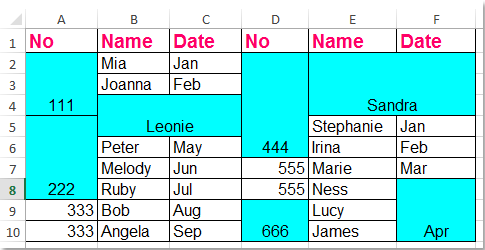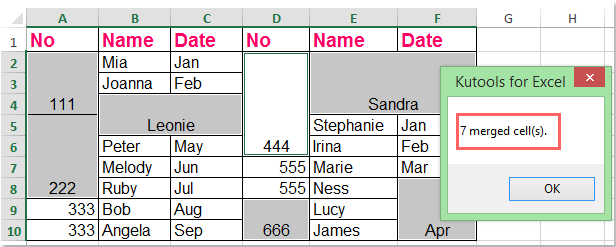如何在 Excel 中识别并选择所有合并的单元格?
你知道如何在 Excel 中查找并选择所有合并的单元格吗?这里有三种巧妙的方法,可以快速识别和选择 Excel 中某个选定区域或范围内的所有合并单元格。

使用“查找”命令识别并选择所有合并的单元格
你可以通过以下步骤使用“查找”命令来识别并选择当前工作表中的所有合并单元格:
1. 点击“开始”选项卡下的“查找与选择”,然后点击“查找”以打开“查找和替换”对话框。你也可以通过按下 Ctrl + F 键打开“查找和替换”对话框。
2. 在对话框中点击“格式”按钮(如果找不到“格式”按钮,请点击“选项”按钮以展开对话框)。请参见截图:

3. 在弹出的“查找格式”对话框中,仅勾选“对齐”选项卡下“文本控制”部分中的“合并单元格”选项,然后点击“确定”。

4. 现在回到“ 查找和替换”对话框,点击“全部查找”按钮。所有合并的单元格都会列在这个对话框的底部。按住 Shift 键选择所有查找结果。
当你选择所有查找结果时,当前工作表中的所有合并单元格都会被选中。请参见截图:

提示:如果你只想在一个选定区域内识别、查找并选择合并的单元格,则需要先选择该区域。
使用 Kutools for Excel 选择并统计所有合并的单元格
Kutools for Excel 的“选择合并单元格”工具可以帮助你一键识别、查找并选择选定区域内的所有合并单元格。
安装 Kutools for Excel 后,请按照以下步骤操作:( 立即免费下载 Kutools for Excel! )
1. 选择要选取合并单元格的数据区域。
2. 点击 Kutools > 选择 > 选择合并单元格,参见截图:

3. 所有选定区域内的合并单元格将一次性被选中,并且还会统计合并单元格的数量,参见截图:
使用 VBA 代码识别所有合并的单元格
VBA 1:识别并高亮显示所有合并的单元格
1. 按住 ALT + F11 键,打开 Microsoft Visual Basic for Applications 窗口。
2. 点击“插入”>“模块”,并将以下宏粘贴到模块窗口中。
Sub FindMergedcells()
'updateby Extendoffice
Dim x As Range
For Each x In ActiveSheet.UsedRange
If x.MergeCells Then
x.Interior.ColorIndex = 8
End If
Next
End Sub
3. 按 F5 键运行此宏。当前工作表中的所有合并单元格都将被识别并高亮显示,参见截图:

VBA 2:识别并列出所有合并的单元格
1. 按住 ALT + F11 键,打开 Microsoft Visual Basic for Applications 窗口。
2. 点击“插入”>“模块”,并将以下宏粘贴到模块窗口中。
Sub ListMergedcells()
'updateby Extendoffice
Dim x As Range
Dim sMsg As String
sMsg = ""
For Each x In ActiveSheet.UsedRange
If x.MergeCells Then
If sMsg = "" Then
sMsg = "Merged cells:" & vbCr
End If
sMsg = sMsg & Replace(x.Address, "$", "") & vbCr
End If
Next
If sMsg = "" Then
sMsg = "No merged cells."
End If
MsgBox sMsg
End Sub
3. 按 F5 键运行此宏,所有合并的单元格都会在一个弹出的对话框中列出。参见截图:

相关文章
如何在受保护的工作表中允许合并单元格?默认情况下,受保护的工作表不允许用户合并单元格。然而,你可以使用我们在此文中提供的 VBA 方法,在受保护的工作表中合并单元格。
如何在 Excel 中合并已格式化为表格的区域中的单元格?在 Excel 中,你可以轻松地使用“合并居中”功能将一些连续的单元格合并为一个,如下图所示。但是,它无法合并已格式化为表格的区域中的单元格,有什么技巧可以解决这个问题吗?
如何在 Excel 中合并单元格但不居中内容?在 Excel 中,当合并两个或多个单元格时,“合并居中”功能可以帮到你。但在某些情况下,如果你只想合并单元格而不居中内容(如下图所示),该怎么办呢?在这里,本教程将介绍在 Excel 中解决此问题的方法。
如何拆分合并的单元格并填充重复值?如果你有一个包含大量合并单元格的工作表,现在你需要拆分它们,并自动向下填充来自原合并单元格的原始值,如下图所示。如何快速完成这项任务?
最佳Office办公效率工具
| 🤖 | Kutools AI 助手:以智能执行为基础,彻底革新数据分析 |代码生成 |自定义公式创建|数据分析与图表生成 |调用Kutools函数…… |
| 热门功能:查找、选中项的背景色或标记重复项 | 删除空行 | 合并列或单元格且不丢失数据 | 四舍五入…… | |
| 高级LOOKUP:多条件VLookup|多值VLookup|多表查找|模糊查找…… | |
| 高级下拉列表:快速创建下拉列表 |依赖下拉列表 | 多选下拉列表…… | |
| 列管理器: 添加指定数量的列 | 移动列 | 切换隐藏列的可见状态 | 比较区域与列…… | |
| 特色功能:网格聚焦 |设计视图 | 增强编辑栏 | 工作簿及工作表管理器 | 资源库(自动文本) | 日期提取 | 合并数据 | 加密/解密单元格 | 按名单发送电子邮件 | 超级筛选 | 特殊筛选(筛选粗体/倾斜/删除线等)…… | |
| 15大工具集:12项 文本工具(添加文本、删除特定字符等)|50+种 图表 类型(甘特图等)|40+实用 公式(基于生日计算年龄等)|19项 插入工具(插入二维码、从路径插入图片等)|12项 转换工具(小写金额转大写、汇率转换等)|7项 合并与分割工具(高级合并行、分割单元格等)| …… |
通过Kutools for Excel提升您的Excel技能,体验前所未有的高效办公。 Kutools for Excel提供300多项高级功能,助您提升效率并节省时间。 点击此处获取您最需要的功能……
Office Tab为Office带来多标签界面,让您的工作更加轻松
- 支持在Word、Excel、PowerPoint中进行多标签编辑与阅读。
- 在同一个窗口的新标签页中打开和创建多个文档,而不是分多个窗口。
- 可提升50%的工作效率,每天为您减少数百次鼠标点击!
所有Kutools加载项,一键安装
Kutools for Office套件包含Excel、Word、Outlook和PowerPoint的插件,以及Office Tab Pro,非常适合跨Office应用团队使用。
- 全能套装——Excel、Word、Outlook和PowerPoint插件+Office Tab Pro
- 单一安装包、单一授权——数分钟即可完成设置(支持MSI)
- 协同更高效——提升Office应用间的整体工作效率
- 30天全功能试用——无需注册,无需信用卡
- 超高性价比——比单独购买更实惠
